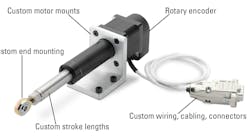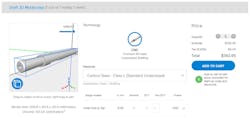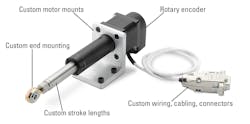The Key to Top-notch Custom Parts for Linear Motion: the Right Vendors
Customization may not always be a factor when designers are selecting motion control vendors. Instead, they are hoping they will find exactly what they need in a catalog and avoid what they believe to be the higher costs, delays and risks associated with custom parts and assemblies. But with more than 25% of linear motion projects requiring some customization, it would likely be beneficial to prepare for that eventuality from the start.
Including customization expertise in the decision on which vendors to use could help avoid higher costs and delays if a linear motion project requires some modifications down the road. And digging into the varying capabilities of different vendors might convince designers that customization can be faster, less expensive, and not as risky as they may have thought.
Here are some points to check before choosing motion-control vendors that will supply custom parts:
Commitment. For some vendors, customization is part of their business model; for others, it is something to be avoided at all costs. If a vendor’s website has dedicated customization pages with detailed lists of characteristics that can be customized, you are probably in good hands. If, on the other hand, there is little or no mention of customization, you should find out why. It could be because of deficiencies in any of the other areas mentioned below on this list.
Experience. How often have they had to modify a product? Can they give examples? How did the need for customization affect cost and delivery?
Capability and scale. Does the vendor have special equipment for customization? What does it do? What is the minimum number of products for which they would consider customization? Are they set up to handle smaller batch runs or will they customize only for large product runs?
Supply chain flexibility. Is the vendor vertically integrated so that it builds most subcomponents from raw materials, or will they be waiting for parts to arrive on the next container boat?
Process. Can the vendor give budgetary quotes right away? How long does it typically take to get a quote for nonstandard products? Will there be a dedicated engineer? Can it build prototypes online? Can it build the part or assembly from a CAD model?
Solving engineering problems. Perhaps the most important factor to consider is the creativity of the vendor’s engineering team in terms of helping clients get the best possible parts and assemblies. Will they take the time to understand the client’s needs?
Although it is common for designers and engineers to think of customization as an all-or-none situation, many needs can be met with relatively simple modifications of standard products. These, depending on the vendor’s experience, can often be delivered in days rather than weeks or months.
Sometimes all that is needed are some specially machined shafts, connectors, or mounting ends. Here are some examples of linear motion customizations that helped designers fit their parts into irregular spaces, improve ergonomics, or lower costs. Adapting to irregular spaces. The need for customization often emerges after the project begins. For example, a company specializing in customized semi-trailers required several modifications to adapt actuators for use in ramps, stairs, and movable floor assemblies. Fitting ramp actuators in the trailer wall required rotating the motor 90 deg. Next, mounting the actuators in custom ramp frames while still connecting to the standard mounting points meant the company had to extend the actuator tube four inches. Finally, to simplify maintenance, the company retrofitted wiring connections with an easily detachable harness.
Lowering the price. In some cases, the need for customization can be met inexpensively by mixing and matching standard components. For example, a supplier of CNC tubing and pipe bending devices sought help in designing a new machine to meet market demand for a scaled-down version. Their high-end offering used two linear slides bolted together in a cross configuration to control motion on X and Z axes. A stepper motor drove a two-foot ball screw on each axis. The length of the screw required support bearings on both ends and a special coupling to the stepper.
The linear motion component supplier first reduced costs by shortening the shaft to an 11-in. lead screw with a 6-in. drive. This eliminated the need for supports at each end. Using a stepper motor with a built-in motorized lead screw (MLS) reduced the need for external support further because the MLS’s motor bearings could support the load themselves. And because the lead screw and MLS rotor are combined into one part, there was no longer a need to externally couple the screw and rotor.
These are but a few customization examples. The range of options is wide. Companies could also customize stroke and extracted length down to millimeter scale; enhance control by adding encoders; comply with industry regulations by adding certification; select a more aesthetically pleasing finish; implement a custom adapter housing; or improve voltages or clutch handling. Even these are just examples of what can be customized on electric actuators. This same degree of customization applies to shafting, screws, ball bushings, linear guides, and a host of other linear motion components.
In these days, in which designers are having to do more, faster, and with fewer people, the more uncertainty they can drive out of the design process, the greater their chances of success. Acknowledging the fact that customizing some aspect of a project is likely and taking a few minutes to ensure you have partnered with a vendor with deep customization capability can save money and avoid headaches down the road.
Kyle Thompson is a product innovation manager at Thomson Industries, Inc.



